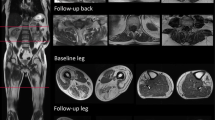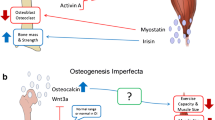Abstract
Results of previous studies suggest that children and adolescents with osteogenesis imperfecta (OI) type IV have muscle force deficits. However, muscle function remains to be objectively quantified in this population. This study aimed to assess upper and lower extremity muscle function in patients with OI type IV. It was carried out in the outpatient department of a pediatric orthopedic hospital; 27 individuals with OI type IV (7–21 years; 13 males), 27 age- and sex-matched individuals with OI type I, and 27 age- and sex-matched controls. Upper extremity muscle force was assessed with hydraulic hand dynamometry, and lower extremity muscle function (peak force per body weight and peak power per body mass) was measured by mechanography through five tests: multiple two-legged hopping, multiple one-legged hopping, single two-legged jump, chair-rise test, and heel-rise test. Upper-limb grip force was normal for patients with OI type IV when compared to height and sex reference data (average z-score = 0.17 ± 1.30; P = 0.88). Compared to age- and sex-matched controls, patients with OI type IV had approximately 30% lower-limb peak force and 50% peak power deficits (P values <0.05). At the lower-limb level, they had a 50% lower peak power than age- and sex-matched patients with OI type I (P < 0.05). Patients with OI type IV have normal upper-limb muscle force but a muscle function deficit at the lower-limb level. These results suggest that lower-limb muscle weakness may contribute to functional deficits in these individuals.



Similar content being viewed by others
References
Rauch F, Glorieux FH (2004) Osteogenesis imperfecta. Lancet 363:1377–1385. doi:10.1016/S0140-6736(04)16051-0
Sillence DO, Senn A, Danks DM (1979) Genetic heterogeneity in osteogenesis imperfecta. J Med Genet 16:101–116
Veilleux LN, Lemay M, Pouliot-Laforte A, Cheung MS, Glorieux FH, Rauch F (2014) Muscle anatomy and dynamic muscle function in osteogenesis imperfecta type I. J Clin Endocrinol Metab 99:E356–E362. doi:10.1210/jc.2013-3209
Veilleux LN, Pouliot-Laforte A, Lemay M, Cheung MS, Glorieux FH, Rauch F (2015) The functional muscle-bone unit in patients with osteogenesis imperfecta type I. Bone 79:52–57. doi:10.1016/j.bone.2015.05.019
Graf A, Hassani S, Krzak J, Caudill A, Flanagan A, Bajorunaite R et al (2009) Gait characteristics and functional assessment of children with type I osteogenesis imperfecta. J Orthop Res 27:1182–1190. doi:10.1002/jor.20871
Caudill A, Flanagan A, Hassani S, Graf A, Bajorunaite R, Harris G et al (2010) Ankle strength and functional limitations in children and adolescents with type I osteogenesis imperfecta. Pediatr Phys Ther. 22:288–295. doi:10.1097/PEP.0b013e3181ea8b8d
Takken T, Terlingen HC, Helders PJ, Pruijs H, Van der Ent CK, Engelbert RH (2004) Cardiopulmonary fitness and muscle strength in patients with osteogenesis imperfecta type I. J Pediatr 145:813–818. doi:10.1016/j.jpeds.2004.08.003
Van Brussel M, Takken T, Uiterwaal CS, Pruijs HJ, Van der Net J, Helders PJ et al (2008) Physical training in children with osteogenesis imperfecta. J Pediatr 152:111–116. doi:10.1016/j.jpeds.2007.06.029
Montpetit K, Palomo T, Glorieux FH, Fassier F, Rauch F (2015) Multidisciplinary treatment of severe osteogenesis imperfecta: functional outcomes at skeletal maturity. Arch Phys Med Rehabil 96:1834–1839. doi:10.1016/j.apmr.2015.06.006
Palomo T, Glorieux FH, Schoenau E, Rauch F (2016) Body composition in children and adolescents with osteogenesis imperfecta. J Pediatr 169:232–237. doi:10.1016/j.jpeds.2015.10.058
Glorieux FH, Rauch F, Plotkin H, Ward L, Travers R, Roughley P et al (2000) Type V osteogenesis imperfecta: a new form of brittle bone disease. J Bone Miner Res 15:1650–1658. doi:10.1359/jbmr.2000.15.9.1650
Glorieux FH, Ward LM, Rauch F, Lalic L, Roughley PJ, Travers R (2002) Osteogenesis imperfecta type VI: a form of brittle bone disease with a mineralization defect. J Bone Miner Res 17:30–38. doi:10.1359/jbmr.2002.17.1.30
Ward LM, Rauch F, Travers R, Chabot G, Azouz EM, Lalic L et al (2002) Osteogenesis imperfecta type VII: an autosomal recessive form of brittle bone disease. Bone 31:12–18
Ogden CL, Kuczmarski RJ, Flegal KM, Mei Z, Guo S, Wei R et al (2002) Centers for Disease Control and Prevention 2000 growth charts for the United States: improvements to the 1977 National Center for Health Statistics version. Pediatrics 109:45–60
Rauch F, Neu CM, Wassmer G, Beck B, Rieger-Wettengl G, Rietschel E et al (2002) Muscle analysis by measurement of maximal isometric grip force: new reference data and clinical applications in pediatrics. Pediatr Res 51:505–510. doi:10.1203/00006450-200204000-00017
Feldman AB, Haley SM, Coryell J (1990) Concurrent and construct validity of the pediatric evaluation of disability inventory. Phys Ther 70:602–610
Bleck EE (1981) Nonoperative treatment of osteogenesis imperfecta: orthotic and mobility management. Clin Orthop Relat Res. 159:111–122
Veilleux LN, Rauch F (2010) Reproducibility of jumping mechanography in healthy children and adults. J Musculoskelet Neuronal Interact 10:256–266
Anliker E, Rawer R, Boutellier U, Toigo M (2011) Maximum ground reaction force in relation to tibial bone mass in children and adults. Med Sci Sports Exerc 43:2102–2109. doi:10.1249/MSS.0b013e31821c4661
Foldvari M, Clark M, Laviolette LC, Bernstein MA, Kaliton D, Castaneda C et al (2000) Association of muscle power with functional status in community-dwelling elderly women. J Gerontol A Biol Sci Med Sci 55:M192–M199
Mathiowetz V, Wiemer DM, Federman SM (1986) Grip and pinch strength: norms for 6- to 19-year-olds. Am J Occup Ther 40:705–711
Sumnik Z, Matyskova J, Hlavka Z, Durdilova L, Soucek O, Zemkova D (2013) Reference data for jumping mechanography in healthy children and adolescents aged 6–18 years. J Musculoskelet Neuronal Interact 13:297–311
Tosi LL, Oetgen ME, Floor MK, Huber MB, Kennelly AM, McCarter RJ et al (2015) Initial report of the osteogenesis imperfecta adult natural history initiative. Orphanet J Rare Dis. 10:146. doi:10.1186/s13023-015-0362-2
Misof K, Landis WJ, Klaushofer K, Fratzl P (1997) Collagen from the osteogenesis imperfecta mouse model (oim) shows reduced resistance against tensile stress. J Clin Invest. 100:40–45. doi:10.1172/JCI119519
Brizola E, Staub AL, Felix TM (2014) Muscle strength, joint range of motion, and gait in children and adolescents with osteogenesis imperfecta. Pediatr Phys Ther. 26:245–252. doi:10.1097/PEP.0000000000000042
Sims TJ, Miles CA, Bailey AJ, Camacho NP (2003) Properties of collagen in OIM mouse tissues. Connect Tissue Res 44(Suppl 1):202–205
Gillies AR, Lieber RL (2011) Structure and function of the skeletal muscle extracellular matrix. Muscle Nerve 44:318–331. doi:10.1002/mus.22094
Huijing PA (1999) Muscle as a collagen fiber reinforced composite: a review of force transmission in muscle and whole limb. J Biomech 32:329–345
Murphy A, Wilson G (1996) Poor correlations between isometric tests and dynamic performance: relationship to muscle activation. Eur J Appl Physiol Occup Physiol. 73:353–357. doi:10.1007/bf02425498
Matheson LA, Duffy S, Maroof A, Gibbons R, Duffy C, Roth J (2013) Intra- and inter-rater reliability of jumping mechanography muscle function assessments. J Musculoskelet Neuronal Interact 13:480–486
Acknowledgements
This study was supported by the Shriners International. F.R. received salary support from the Chercheur-Boursier Clinicien program of the Fonds de Recherche du Québec—Santé. L.N.V. received postdoctoral fellowships from the Fonds de la Recherche du Québec—Santé and the MENTOR-RSBO (Network for Oral and Bone Health Research), supported by the Canadian Institutes of Health Research (MENTOR) and the Fonds de la Recherche du Québec—Santé (RSBO). The funding agencies were not involved in the design of the study, collection, analysis, and interpretation of data and in writing the manuscript.
Author’s Contribution
Veilleux LN conceptualized and designed the study, carried out the analyses, drafted the initial manuscript. He is the guarantor. Darsaklis VB participated in data collection and interpretation. Montpetit K participated in data collection and interpretation. Glorieux FH contributed patient information and participated in the interpretation of data. Rauch F contributed patient information, conceptualized and designed the study and participated in the interpretation of data. All authors revised the paper critically for intellectual content and approved the final version. All authors agree to be accountable for the work and to ensure that any questions relating to the accuracy and integrity of the paper are investigated and properly resolved.
Author information
Authors and Affiliations
Corresponding author
Ethics declarations
Conflicts of interest
The authors declare that there are no potential conflicts of interest with respect to the research, authorship, and/or publication of this article.
Human and Animal Rights and Informed Consent
All procedures followed were in accordance with the ethical standards of the responsible committee on human experimentation (institutional and national) and with the Helsinki Declaration of 1975, as revised in 2000. Informed consent was obtained from study participants or the legal guardians.
Rights and permissions
About this article
Cite this article
Veilleux, LN., Darsaklis, V.B., Montpetit, K. et al. Muscle Function in Osteogenesis Imperfecta Type IV. Calcif Tissue Int 101, 362–370 (2017). https://doi.org/10.1007/s00223-017-0287-y
Received:
Accepted:
Published:
Issue Date:
DOI: https://doi.org/10.1007/s00223-017-0287-y




